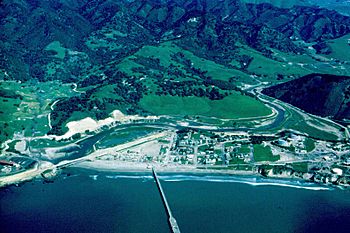San Luis Obispo Creek facts for kids
Quick facts for kids San Luis Obispo Creek |
|
|---|---|

San Luis Obispo Creek at Avila Beach, 1969
|
|
| Country | United States |
| State | California |
| County | San Luis Obispo |
| Physical characteristics | |
| Main source | Santa Lucia Mountains 1,559 ft (475 m) 35°20′56″N 120°37′52″W / 35.34889°N 120.63111°W |
| River mouth | Pacific Ocean Avila Beach 0 ft (0 m) 35°10′46″N 120°44′18″W / 35.17944°N 120.73833°W |
| Length | 17.7 mi (28.5 km) |
| Basin features | |
| Basin size | 84.8 sq mi (220 km2) |
The San Luis Obispo Creek is a cool stream, about 18 miles (29 km) long, located in San Luis Obispo County, California. It flows through a big area of land called a watershed, which includes the city of San Luis Obispo. Finally, it empties into the Pacific Ocean at Avila Beach.
Contents
Where Does San Luis Obispo Creek Flow?
The San Luis Obispo Creek starts high up in the Santa Lucia Mountains. This is near Cuesta Pass, inside the Los Padres National Forest. The creek then flows south through a steep canyon.
It passes under U.S. Highway 101. As it gets closer to the city of San Luis Obispo, it turns southwest. The creek winds through neighborhoods and past San Luis Obispo High School.
The Creek's Journey Through Downtown
In downtown San Luis Obispo, the creek flows in a special channel. It even goes into a concrete tunnel about 1,000 feet (300 meters) long. After the tunnel, it flows past the historic Mission San Luis Obispo de Tolosa.
It then meets Stenner Creek, another smaller stream. Below downtown, the creek continues south. It flows through industrial areas and farmlands.
The Creek's Path to the Ocean
Near Los Osos Valley Road, two more creeks, Prefumo Creek and Froom Creek, join it. The creek then leaves the city. It enters a canyon next to the Irish Hills.
Here, the East Fork of San Luis Obispo Creek and Davenport Creek add their waters. The creek then turns west and meets See Canyon Creek. Finally, it forms a small estuary, which is where fresh water mixes with ocean water. It then flows into the Pacific Ocean at San Luis Obispo Bay, close to Avila Beach.
What Is the San Luis Obispo Creek Watershed?
The San Luis Obispo Creek watershed is a large area of land. It covers about 84.8 square miles (219.6 km²). A watershed is all the land where water drains into a specific river or creek.
Most of this area is open land for grazing animals and natural spaces. There are also some farms and orchards. About 11 percent of the watershed is city area, mostly in San Luis Obispo.
Climate and Rainfall
The watershed has a moderately wet Mediterranean climate. This means it has mild, wet winters and warm, dry summers. On average, it gets about 24 to 29 inches (610 to 737 mm) of rain each year.
Main Parts of the Watershed
- East Fork of San Luis Obispo Creek: This is the biggest part of the watershed. It drains most of the southern part of San Luis Obispo city.
- Stenner Creek: This is the second largest part. It drains northern San Luis Obispo. It includes smaller streams like Brizzolara Creek and Old Garden Creek. Brizzolara Creek flows through the Cal Poly campus.
- Prefumo Creek: This is the third largest part. It drains Laguna Lake. Laguna Lake is one of the few natural lakes in San Luis Obispo County. It also drains parts of the Irish Hills Natural Reserve.
What Animals Live in San Luis Obispo Creek?
Over the years, people have built things that blocked fish from moving freely in the creek. However, some of these barriers have been removed. For example, Stage Coach Dam was taken down in 2002. This helps fish swim more easily.
Beavers in the Creek
North American beaver (Castor canadensis) are large rodents known for building dams. Some people thought beavers were not originally from San Luis Obispo Creek. However, a historical record from 1774 suggests otherwise.
In April 1774, Father Cavaller of Mission San Luis Obispo de Tolosa gave explorer Juan Bautista de Anza "thirty-odd beaver skins." This shows that beavers were likely living in the area a long time ago. The region was also known for its bears.
Images for kids
See also
 In Spanish: Arroyo San Luis Obispo para niños
In Spanish: Arroyo San Luis Obispo para niños



